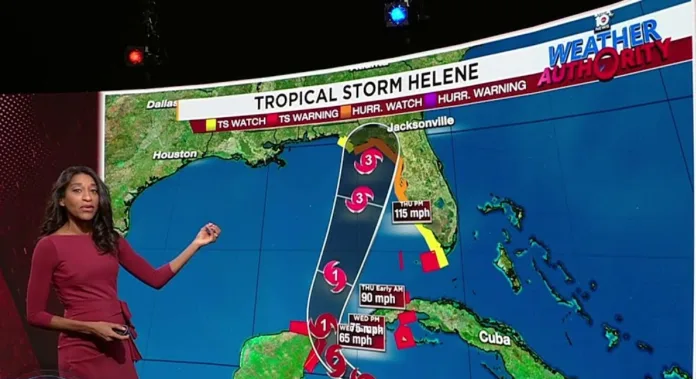Tropical storm Helene rapidly intensifies as it heads toward the Gulf Coast, prompting widespread hurricane warnings and preparations
On the morning of September 24, 2024, Tropical Storm Helene formed in the Caribbean, quickly gaining strength and prompting concerns across Florida. The National Hurricane Center (NHC) reported that the storm’s centre was located approximately 100 miles east-southeast of Cozumel, Mexico, with sustained winds increasing from 50 mph to 60 mph by the 11 p.m. advisory. The storm moved west-northwest at 10 mph, making it a significant threat to the Gulf Coast.
NHC Deputy Director Jaime Rhome emphasized the potential impact of Helene, stating, “It is going to be a big storm, and by big I mean not intensity, I mean size. And big storms cause big problems.” This warning came as forecasters anticipated the storm to strengthen into a Category 3 hurricane by Thursday night, with wind speeds reaching up to 120 mph and gusts peaking at 150 mph.
In preparation for Helene’s arrival, the NHC issued a hurricane warning for the stretch between Anclote River and Mexico Beach, Florida. A storm surge warning also went into effect for Indian Pass south to Flamingo, including Tampa Bay and Charlotte Harbor. Residents can expect surges of up to 15 feet above normal levels, creating dangerous conditions along the Gulf Coast. Rhome noted the vulnerability of the western Florida peninsula, asserting that even tropical storm-force winds could produce life-threatening storm surges.
The forecast indicated that the hurricane’s impacts would extend well beyond its centre, particularly on the storm’s eastern side. Tropical-storm-force winds, which currently extend 175 miles from the storm’s centre, are expected to grow to as much as 250 miles. NHC Warning Coordination Meteorologist Robbie Berg remarked, “Storm surge, wind, and rainfall impacts will likely extend well away from the centre and outside the forecast cone.” This broad impact will likely push strong winds further inland after landfall.
In addition to hurricane warnings, the NHC issued a hurricane watch for the area from Englewood to the Anclote River, including Tampa Bay. A tropical storm warning was activated for various regions, including the Dry Tortugas, Lower and Middle Florida Keys, and from Flamingo to the Anclote River, as well as parts of Central Florida. Tropical storm warnings now extend around much of the state, with inland warnings covering counties such as Brevard, Lake, Marion, Orange, Osceola, Polk, Seminole, Sumter, and Volusia.
As the storm’s trajectory continues to develop, residents across Florida remain on high alert, monitoring updates and preparing for what could be a significant hurricane event.
Analysis:
Political Perspective: The impending arrival of Tropical Storm Helene underscores the ongoing challenges of disaster preparedness and response within the state of Florida. Local and state officials face pressure to implement effective evacuation and safety measures. The response to the storm highlights the importance of coordination between federal, state, and local agencies to ensure community safety. As seen in previous storms, political leaders must navigate public communication, funding for emergency services, and infrastructure resilience amid increasing climate-related events.
Social Perspective: Helene’s formation resonates with Florida’s unique relationship with hurricanes. For many residents, tropical storms evoke memories of past disasters and a sense of urgency in preparing for the potential impact. The storm serves as a reminder of the vulnerabilities faced by coastal communities, particularly those with limited resources. As families gather supplies and plan evacuations, the social dynamics of community support come to the forefront, revealing how neighbours often band together in times of crisis.
Racial Perspective: The impact of Hurricane Helene could disproportionately affect marginalized communities along the Gulf Coast. Low-income neighbourhoods often reside in areas more vulnerable to flooding and storm surges, and residents may lack the financial means to evacuate or prepare adequately. The ongoing discourse surrounding race and climate resilience highlights the need for equitable disaster response strategies that prioritize the safety of all citizens, regardless of socioeconomic status.
Gender Perspective: The storm also has gender implications, particularly in how households prepare for and respond to disasters. Women often take on the role of caregivers and primary planners in emergency situations. Their experiences and needs during evacuations may differ from those of men, and it is crucial for emergency management plans to consider these differences to ensure the safety and well-being of all community members.
Economic Perspective: Tropical Storm Helene poses significant economic implications for Florida, particularly in sectors such as tourism and agriculture. Coastal communities heavily rely on tourism revenue, and the threat of a major hurricane can deter visitors and disrupt local economies. Additionally, agriculture in the region may face crop damage and supply chain disruptions due to strong winds and storm surges. Policymakers and local business owners must assess the potential economic fallout and plan for recovery efforts to mitigate long-term impacts.
